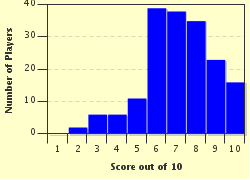Quiz Answer Key and Fun Facts
1. After a volcanic eruption, a colored ring of dust particles can sometimes be seen around the sun. The ring is named for which of these?
2. In the USA the measure of what hot weather feels like to an average person in different temperatures and humidities is known as what?
3. From 1967 to 1969, a city in which American state held the record for the most consecutive days of sunshine, at 768 days?
4. A period of extremely hot weather that happens in the Northern Hemisphere during the months of July and August goes by what nickname?
5. Lightning will not strike the same person, or the same place, a second time.
6. A fulgurite is a piece of petrified hot lightning created when lightning hits dry sand. In what language does fulgur mean lightning?
7. A lightning bolt is six times hotter than the sun.
8. In relation to lightning, what is the corona envelope?
9. Due to what natural disaster was 1816 known around the world as the year without a summer?
10. There are several different types of lightning strokes. Which of these is a real lightning stroke?
Source: Author
pennie1478
This quiz was reviewed by FunTrivia editor
rossian before going online.
Any errors found in FunTrivia content are routinely corrected through our feedback system.


